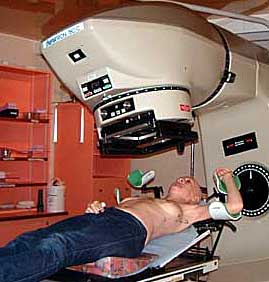| Keeping abreast in Paris provokes images like this... | ||
 | or maybe this... |  |
 |
| |
| I requested to move to the Curie Institut for this stage, not only because it was soothing to be next to the place where Marie Curie developed the treatment. Also I could walk from my apartment in the 3rd arrondissement to the Institute in the 5th. It took 35 minutes to get there (usually in high gear so not to be late). The return was reserved for exploring different Parisian haunts, which took my mind off the more gruesome aspects of this whole dilemma and alleviated the otherwise monotonous task. The exercise didn't do any harm either. Imposing-looking machines deliver the rays. It takes only a minute for each targeted area. You can be in and out in 20 minutes. It takes longer when you use both the proton and electron machines. You have to go from one to the other and get "positioned," risking yet another chance the nurse's cold hands on your nude torso on the table sends shivers down your spine. This is NOT the time to bring out your low-neckline frocks. Clinicians use various colored markers that can extend to the collarbone. They stick bits of tape over the marks so they won't wash away. Invariably they do, but you get remarked as needed. No baths, no swimming, don't do anything that will soak them off. The X-markings are crucial to directing the beam, aligning your chest with the machine's emissions. You are doing this because tumour cells are more susceptible to radiation damage than normal cells. Because they are growing without restraint, cancer cells do not have the ability to repair themselves as well as normal cells do. Radiotherapy is like surgery only the scalpel is replaced by a particle beam that cuts out the DNA that causes cell multiplication, thus encouraging cancer cells to die. Beams emitted may be high voltage to go deep or less and more more superficial. It depends on where the tumor is. Only a one or two-inch area get beamed. The up side: Compared to chemo, you feel fine. The down side:
Its...just so-o mechanical. You come in, you go out. No discomfort, no guarantees. | ||
chemotherapy • hair (or lack thereof) • "fallout" entry page